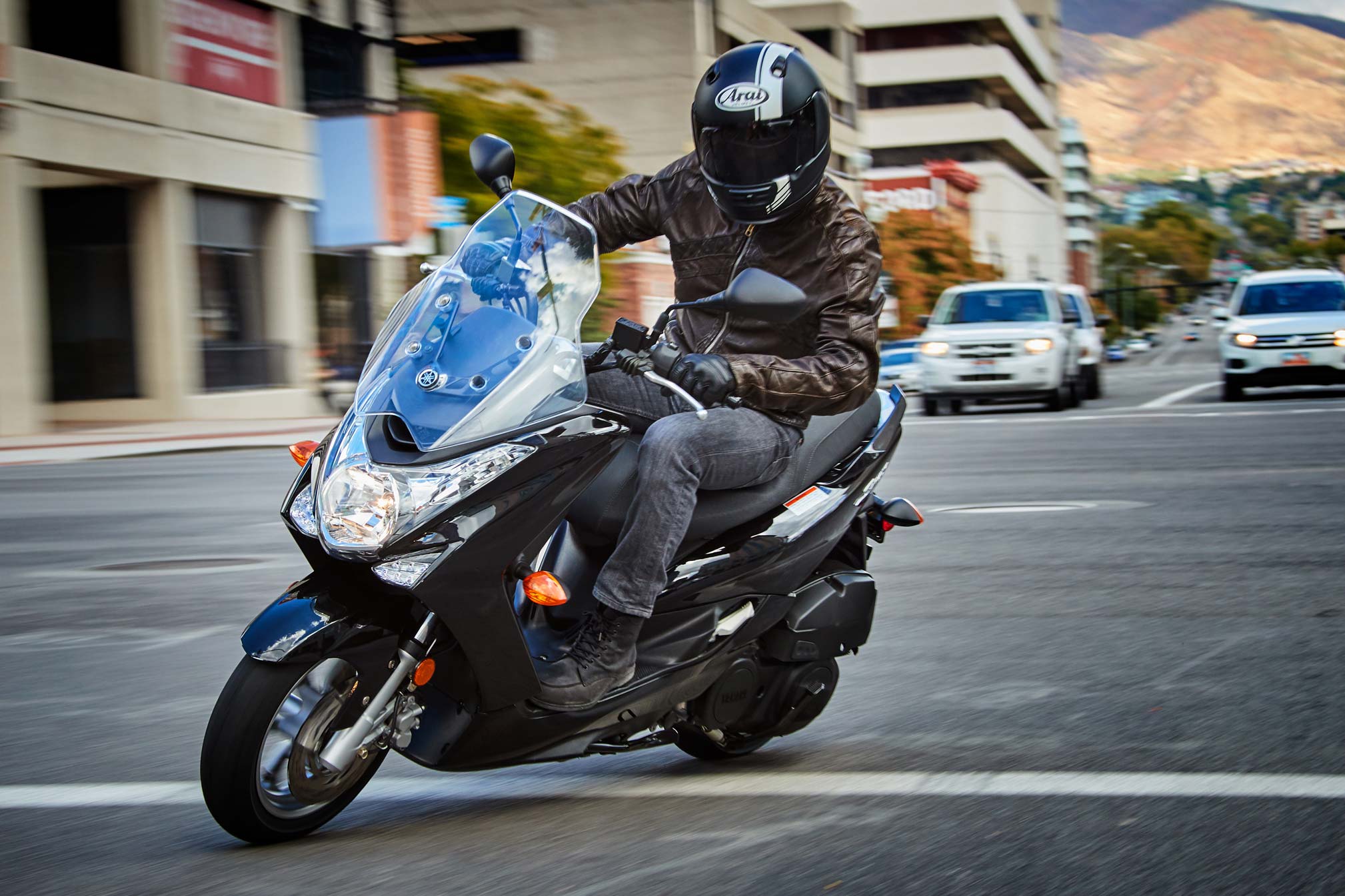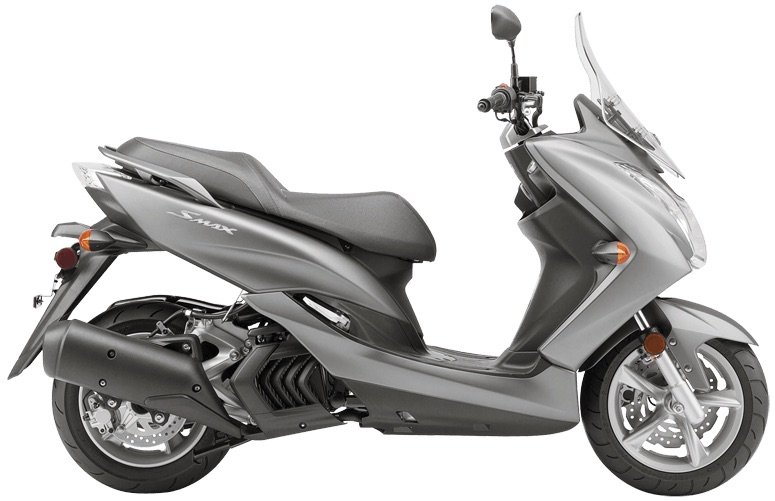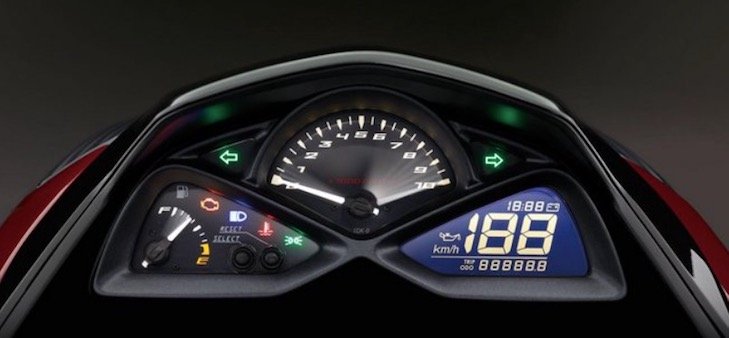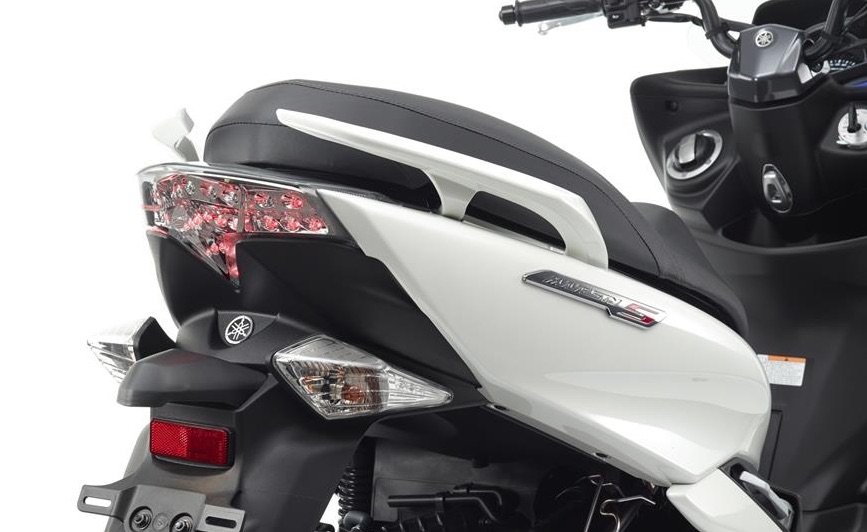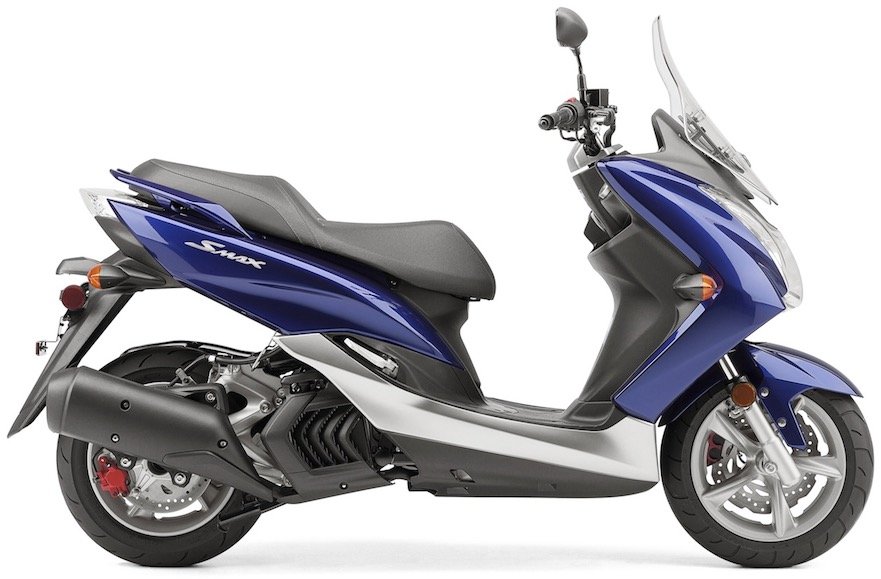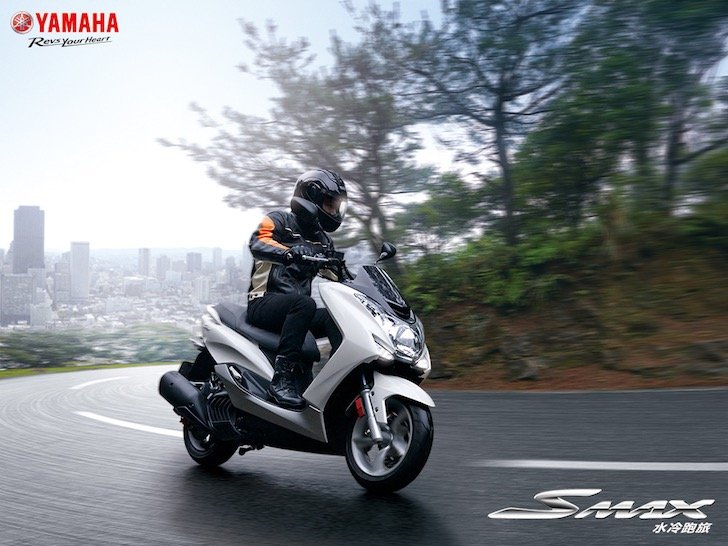YAMAHA SMAX (XC155)
The SMAX is Yamaha’s flagship model in the midsized market. This design was first unveiled in early 2014 and announced that fall for the American and Canadian markets as a 2015 model.
The SMAX remains on sale in both markets as of 2020. The SMAX takes on popular scooters like Honda’s PCX 150 in the mid sized category. With excellent refinement and excellent power and milage, the SMAX is one of the most stylish and practical scooters available.
Model Background
For 2015, the SMAX was introduced as an entirely new model from Yamaha. However, the naming and model code have ties to older Yamaha models which are worth understanding. The “XC” component of the XC155 model code is used by Yamaha for smaller wheeled modern styled machines (as opposed to large wheeled, sports or retro styled scooters). The first usage of the XC code was with the 1983 Riva 180 (XC180) although the Riva 125 (XC125) is better known in North America. In a vague sense the SMAX could be considered a successor to the Riva 125 (1985 – 2006), but Yamaha designed and sold many intervening models between these two which never arrived in smaller North America market. More obviously, the final 155 component of the model code refers to the engine displacement.
The XC155 is sold globally under two names: SMAX and Majesty S. The SMAX name is more widespread and is being used in North America, while Majesty S is mostly used in European markets. The SMAX name connects this scooter with Yamaha’s TMAX and XMAX scooters, which are typically a bit sportier than Yamaha’s Majesty designs. The Majesty name has a long history of usage in scooters of mid and large displacement, such as the aging Majesty 400 which is still offered in North America despite newer iterations available overseas.
Design
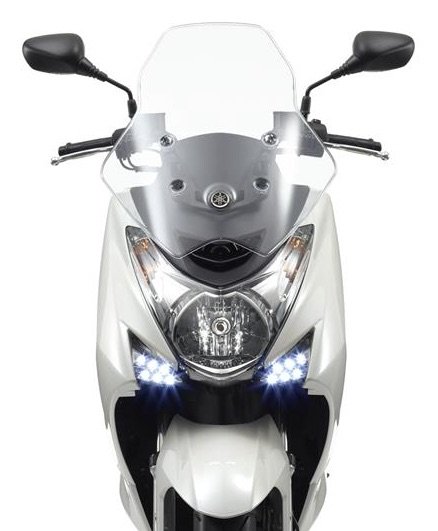
Overseas the SMAX uses small integrated blinkers above the headlight (shown at left), but DOT regulations in North America require wider spacing which is why the SMAX (and most scooters here) has protruding side blinkers that look like the after thought they are (see top photo).
The other noteworthy aspect of the SMAX design is the gauges, which utilize a tasteful three gauge cluster. A large analog tach occupies the center position, while a digital speedometer and analog fuel gauge reside on the right and left flanks respectively.
Yamaha claims a huge focus on ergonomics and comfort with the SMAX design. This scooter is physically fairly large for a mid-sized machine, so Yamaha has been able to provide a bit more space in the cockpit that the average scooter. At 55.3”, the wheelbase is 4” longer than Honda’s competing PCX 150, while not quite as long as Suzuki’s maxi styled, 57” wheelbase Burgman 200. Foot room is plentiful with the large flat floor. The seat is also quite large, but riding position is constrained by the stepped design which disallows drivers from sliding back. With the larger cockpit most riders won’t feel the need to slide back, but large riders might find their options limited.
The downsides to the SMAX design are few. The use of a steel underbone frame is a drawback both in terms of handling and its contribution to this machines 329 lbs heft. An aluminum frame would be excellent, but the SMAX engineers needed to keep a careful mind to price and they chose to invest elsewhere, such as the motor. An aesthetic downside is the huge rear fender which undoubtably functions well but will commonly be removed. Additionally the rims are generic and uninspired, as is the entire scooter from a few angles.
Motor
Yamaha clearly put a substantial portion of their engineering budget into the SMAX motor. All the usual goodies are here like fuel injection and 4-valves as are a long list of high tech features rarely found in a scooter: roller rocker arms, ceramic plated aluminum cylinder, forged aluminum piston and true closed loop control for the fuel injection system. The result is a cutting edge motor that revs way up to 9500 RPM.
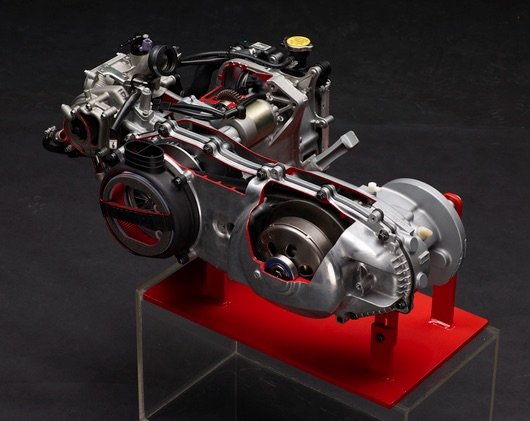
Overall, Yamaha biased this motor a bit more towards power than fuel milage, but this power doesn’t necessarily translate into faster acceleration or top speed (70 mph) than competing models, as SMAX motor has to deal with moving a fairly large machine around. It’s probably fair to say that all this technology goes towards making a larger than average machine accelerate and sip fuel like a smaller, lighter machine.
Storage & Convenience
The style of the SMAX isn’t pure maxi, and neither is the feature set. The SMAX contains a reasonable list of features but it’s certainly no Burgman. The main underseat storage compartment contains a typical 8 gallons of space that will accommodate most any lid. There is also a storage slot on the legshield which is flanked on the left by the fuel door. This storage slot is a good size, but an open area is far less useful than a closed, locking glove box. There is also a bag hook, which will typically see little use but it’s a nice thing to have for grocery runs.
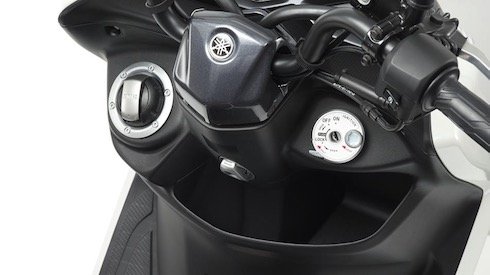
Also noteworthy is the windscreen, which is large and standard equipment in North America. This windscreen clutters up the front end aesthetics but most riders will find it worth retaining as it does provide a substantial amount of wind blocking.
Brakes and Suspension
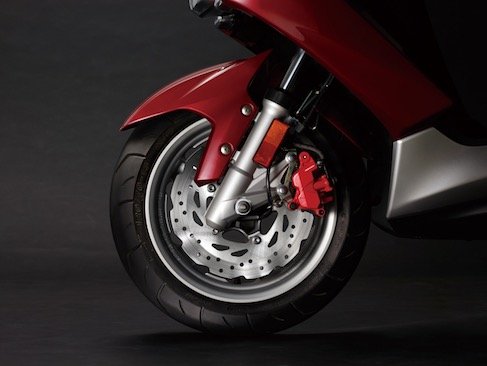
The front suspension is pretty standard with just over 3” of travel from the 33mm diameter forks. The rear suspension is a unique design in the scooter world however, as it uses a mid-scooter mounted single shock akin to a dirt bike. Yamaha claims this centralizes mass for better handling. The idea that shifting forward a 1 pound shock in a machine weighing 329 lbs improves handling is pure marketing spin, but there are some other advantages. By locating a single shock in front of the wheel rather than beside, it’s likely possible to achieve nearly the torsional rigidity of dual shocks without the heft. This design also cleans up the aesthetics of the rear end and makes the coil spring less prone to collecting airborne debris from the rear wheel.
Comparison
The SMAX is clearly targeted at the same niche as Honda’s successful PCX150, however they differ in a number of meaningful ways. The 45 lbs lighter PCX wins in a number of areas including milage (90 mpg vs 75 mpg), lockable front storage and price ($3449 vs. $3690 in the USA), while the SMAX boasts envious engine technology, more cockpit space, a handy flat floorboard and a rear disc brake. The SMAX makes more power (14.8 HP vs 13.4 HP) but that advantage is lost to its extra bulk, so acceleration and top speed are a wash. Bigger riders will likely prefer the SMAX, while most riders will have to weigh the pros and cons. Styling is nice on both machines, but the PCX has a more unique look which is probably a little nicer.
Other machines worth considering are Kymco’s Movie 150, Piaggio’s Fly 150 and the Burgman 200. The Movie 150 is a nice machine at a lower price ($3199). It lags these Japanese scooters in technology, but it’s a solid performer at a good price. The Fly 150 is also an attractively priced machine ($2999) with similar drawbacks (older technology means a bit less power and fuel efficiency).
Conversely, Suzuki’s Burgman 200 is an extra thousand ($4999) and comes with reduced fuel economy (65 mpg) but it adds another 5-10 mph of top speed making it more suited for bigger riders or freeway use. The Burgman 200 also adds many maxi scooter amenities including ABS, which makes it a great machine to be on if you’re travelling longer distances.
Pros:
- Outstanding motor technology
- Solid brakes
- Roomy ergonomics
Cons:
- Heavy
- Generic rims
Links:
MotorscooterGuide Forums – Visit the forum on this site to chat about this scoot.
SMax video walk around – Nice look at the SMax design
Key Specs:
- Engine: 155cc liquid cooled, 4-valve, 4-stroke
- Bore and Stroke: 58.0 x 58.7mm
- Compression Ratio: 11.0:1
- Max Power: 14.8 HP, 10 lbs-ft torque @ 6000 RPM
- Fuel Delivery: 30mm fuel injection (closed loop)
- Ignition: TCI electric start
- Transmission: CVT
- Suspension (Front): 3.1” travel via 33mm telescopic fork
- Suspension (Rear): 3.6” travel via single mid-mounted shock
- Brakes (Front): 267mm dual piston disc brake
- Brakes (Rear): 245 mm single piston disc
- Tires: 120/70-13 (front), 130/70-13 (rear)
- Length: 78”
- Width: 28.1”
- Height: 51”
- Wheelbase: 55.3”
- Ground Clearance: 3.5”
- Seat Height: 31.3”
- Fuel Capacity: 2.0 gallon
- Wet Weight: 329 lbs
- Max Load: 352 lbs
- MSRP: $3699 (2015-17)
Colors:
- 2015: Matte Titan, Ultramarine Blue (aka Dark Purplish Metallic Blue in Canada)
- 2016: Gun Metal Gray, Candy Red (aka Dark Metallic Gray and Deep Metallic Red in Canada)
- 2017-2018: Raven (aka Metallic Black in Canada)
- 2019 – 2010: Candy Red (USA), Dark Gray (Canada)

